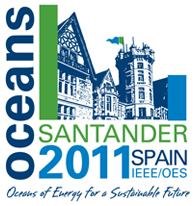

N. Martins nmartins@ualg.pt, P. Felisberto pfelis@ualg.pt and S.M. Jesus sjesus@ualg.pt
Instituto de Sistemas e Robótica, Universidade do Algarve,
Campus de Gambelas, PT-8005-139 Faro, Portugal.
Comments: download extended abstract (pdf file).
Ref.: submitted to OCEANS'11, Santander, Spain, June 2011.
Abstract
It is widely recognized that anthropogenic noise affects the marine fauna, thus becoming a major concern in ocean management. In the other hand, there is an increasing demand for renewable sources of energy, among which wave energy is a potential candidate. Wave energy installations are presumably an important source of noise, thus, a noise prediction tool is of crucial importance to assess the impact of a prospective installation. The development of such a tool is one of the objectives of the Wave Energy Acoustic Monitoring (WEAM) project. The basic idea consists of taking representative acoustic measures at the site, to infer optimal values for the parameters of a propagation model, with an assumed environmental structure. In this context, the CALCOM'10 sea trial took place off the south coast of Portugal, with the purpose of gathering in situ acoustic fieds. With the tuned parameters, the model should give acoustic field outcomes very close to the measures, and this consists of a field calibration scheme, as is done for example in geology. This scheme resorts to "acoustic inversion", which will be adapted the considered environmental structure, like the ocean horizontal layers, bathymetric structure, etc. The applications of acoustic inversion are at least twofold: to find the values of environmental parameters unknown to the modeler, and to refine the values of known parameters. In the present application, the accuracy of the parameters estimated by acoustic means is not a concern, but only the uncertainty of the predicted acoustic field. The objective is to reduce the need for extensive surveys, and reduce the influence of modeling errors, for example that due to the bathymetric discretization used. (continue on pdf file)